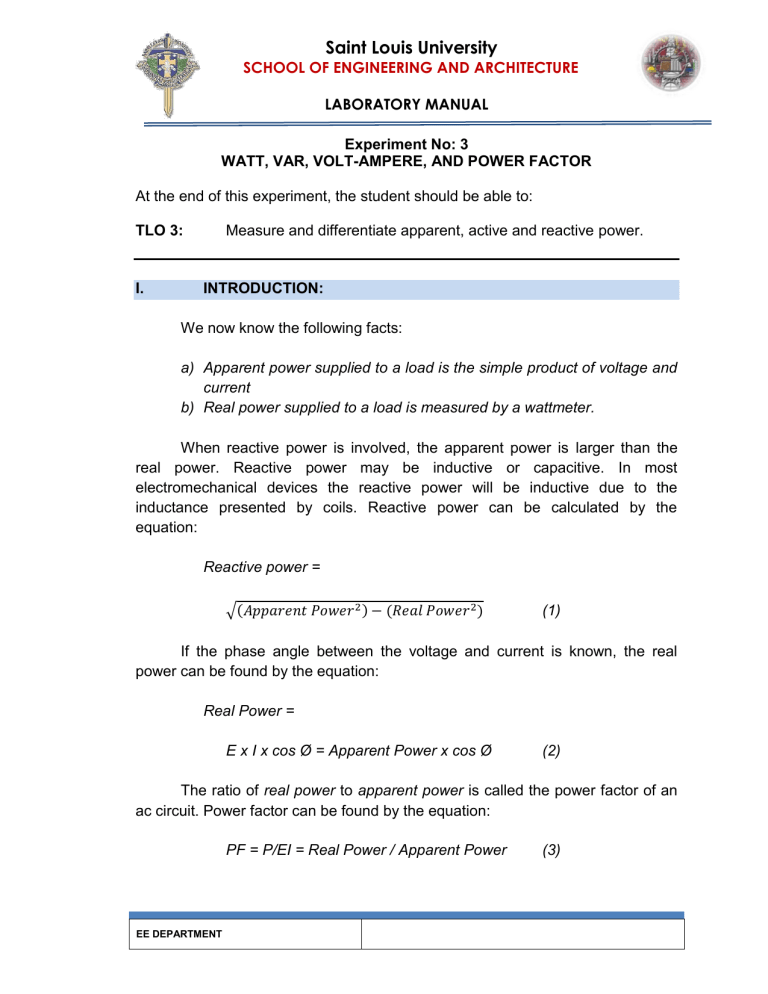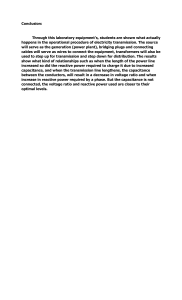
Saint Louis University SCHOOL OF ENGINEERING AND ARCHITECTURE LABORATORY MANUAL Experiment No: 3 WATT, VAR, VOLT-AMPERE, AND POWER FACTOR At the end of this experiment, the student should be able to: TLO 3: I. Measure and differentiate apparent, active and reactive power. INTRODUCTION: We now know the following facts: a) Apparent power supplied to a load is the simple product of voltage and current b) Real power supplied to a load is measured by a wattmeter. When reactive power is involved, the apparent power is larger than the real power. Reactive power may be inductive or capacitive. In most electromechanical devices the reactive power will be inductive due to the inductance presented by coils. Reactive power can be calculated by the equation: Reactive power = √(𝐴𝑝𝑝𝑎𝑟𝑒𝑛𝑡 𝑃𝑜𝑤𝑒𝑟 2 ) − (𝑅𝑒𝑎𝑙 𝑃𝑜𝑤𝑒𝑟 2 ) (1) If the phase angle between the voltage and current is known, the real power can be found by the equation: Real Power = E x I x cos Ø = Apparent Power x cos Ø (2) The ratio of real power to apparent power is called the power factor of an ac circuit. Power factor can be found by the equation: PF = P/EI = Real Power / Apparent Power EE DEPARTMENT (3) Saint Louis University SCHOOL OF ENGINEERING AND ARCHITECTURE LABORATORY MANUAL The value of the power factor depends on how much the current and voltage are out of phase. When the current and voltage are in phase, the real power is equal to I x E, or in other words, the power factor is unity. When current and voltage are out of phase by 90, as in purely capacitive or inductive circuit, the power factor is zero, resulting in a zero value of actual power. In circuits containing both resistance and reactance, the value of the power factor is some value between one and zero. If the phase angle Ø between the voltage and current is known the power factor can be found by the equation: PF = cos Ø (4) Alternating current motors draw reactive power from the supply line to create the magnetic field which they require. In addition, such motors also absorb real power, most of which is converted into mechanical power, while the rest is dissipated in the form of heat. The reactive power travels back and forth between the motor and the ac supply. Reactive power does no useful work, except in so far as it creates placed in parallel with the motor, and the reactive power drawn by the capacitor is exactly equal (but of opposite sign) to that drawn by the motor, then one reactive power will neutralize the other. The result being that the power transmission line need no longer carry any reactive power at all. This can result in a very substantial reduction of current in the transmission line, which improves line regulation and reduces need for large diameter transmission wires. Prior to the addition of the capacitor, the power factor of the motor is quite low. Once the capacitor is in place, the combination (motor + capacitor) improves the power factor. By proper choice of capacitance, the power factor can be made close to unity. NOTE: In this Laboratory Experiment, the Split-Phase/Capacitor Start Motor will be fully explained to you in later Laboratory Experiments. EE DEPARTMENT Saint Louis University SCHOOL OF ENGINEERING AND ARCHITECTURE LABORATORY MANUAL II. EQUIPMENT/ MATERIALS NEEDED: Power Supply Module (120Vac) Split-Phase/Capacitor Start Motor Module AC Metering Module (2.5A/8A) AC Metering Module (250V) Capacitance Module (2) Single-Phase Wattmeter Module (750W) Connection Leads III. EMS 8821 EMS 8251 EMS 8425 EMS 8426 EMS 8331 EMS 8431 EMS 8941 PROCEDURES: TLO 3: Measure and differentiate apparent, active and reactive power. Caution: High voltages are present in this Laboratory Experiment! Do not make any connections with the power on! The power should be turned off after completing each individual measurement! 1. Using your EMS Split-Phase/Capacitor Start Motor, AC Metering, Wattmeter and Power Supply Modules, connect the circuit shown in Fig. 3-1. Use short leads to tie terminals 1 to 3, 2 to 6 and 4 to 7 on your Motor Module. (The motor is now connected for split-phase operation). DO NOT APPLY POWER AT THIS TIME! Fig 3-1 2. Have your connected circuit checked by your instructor. 3. Turn on the power supply and adjust for 120Vac as indicated by the ac voltmeter connected across the motor. (Your motor should be running). EE DEPARTMENT Saint Louis University SCHOOL OF ENGINEERING AND ARCHITECTURE LABORATORY MANUAL a) Measure and record the line current. IL = ___________ Aac b) Measure and record the real power. P = ___________ W 4. a) Return the voltage to zero and turn off the power supply. b) Calculate the apparent power. PA = ___________ VA c) Calculate the power factor. PF = ___________ d) Calculate the reactive power. PR = ___________ var 5. Connect two Capacitance Modules in parallel with your motor as shown in Fig. 3-2. Connect all six of the capacitance sections in parallel. Open (down position) all of the associated capacitor toggle switches. 6. a) Turn on the power supply and adjust for 120Vac as Procedure 3. (Your motor should be running). b) Start to add capacitance to your circuit by closing the switches one at a time. Note that the line current diminishes as capacitance is added. At some point, as you keep adding more capacitance the line current will start to increase. (The line current has gone through a minimum value). c) Adjust your capacitance for minimum line current. d) Measure and record the line current. IL = ___________ Aac e) Measure and record the real power. EE DEPARTMENT Saint Louis University SCHOOL OF ENGINEERING AND ARCHITECTURE LABORATORY MANUAL P = ___________ W 7. a) Return the voltage to zero and turn off the power supply. b) Calculate the apparent power. PA = ___________ VA c) Calculate the power factor. PF = ___________ d) Calculate the reactive power. PR = ___________ var Fig. 3-2 8. Compare the results of Procedure 3 and 4 with the results of Procedure 6 and 7. a) Has there been a significant reduction in line current by adding capacitance? _________ b) Has the motor operation been affected by adding capacitance? __________ c) Is the real power approximately the same whether the capacitance is added or not? _________ Explain. ___________________________________________________________ EE DEPARTMENT Saint Louis University SCHOOL OF ENGINEERING AND ARCHITECTURE LABORATORY MANUAL ___________________________________________________________ ___________________________________________________________ ________________________________________________________________ 9. Turn on the power supply and adjust for 120Vac as before. a) Close all of the capacitance switches and measure the line current. IL = ___________ Aac b) Carefully adjust the switches for minimum line current, while maintaining exactly 120Vac across the motor. What reactance value gives the lowest line current? XC = ___________ Ω c) Return the voltage to zero and turn off the power supply. IV. REFERENCES: LabVolt Manual EE DEPARTMENT





